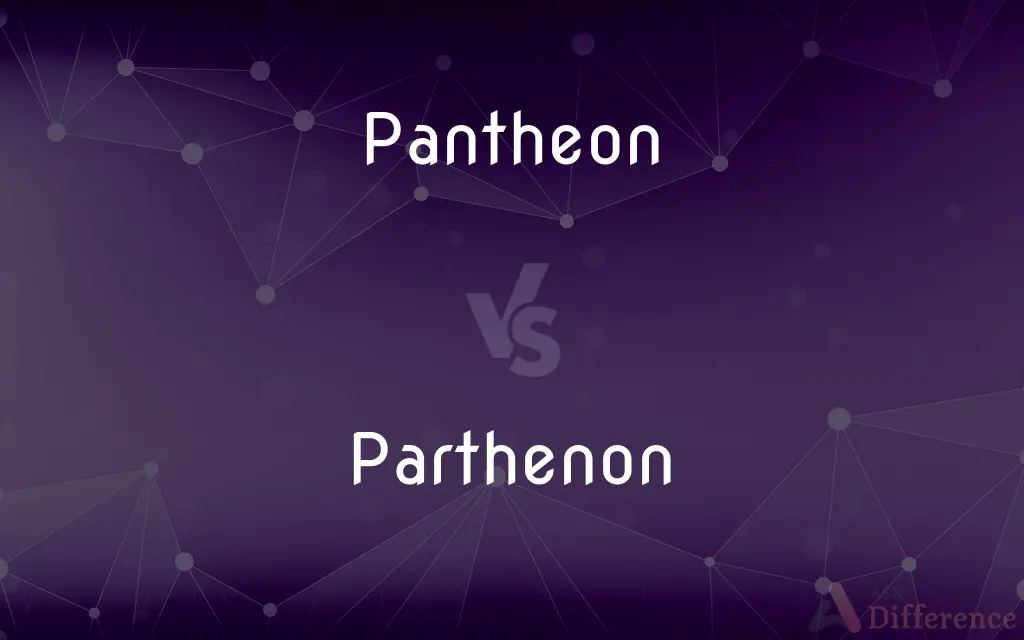Pantheon vs. Parthenon — What's the Difference?
By Tayyaba Rehman — Updated on October 27, 2023
The Pantheon is an ancient Roman temple in Rome, while the Parthenon is an ancient Greek temple on the Acropolis in Athens.

Difference Between Pantheon and Parthenon
Table of Contents
ADVERTISEMENT
Key Differences
The Pantheon, situated in Rome, Italy, is one of the most well-preserved of all the ancient Roman buildings. The Parthenon, on the other hand, stands atop the Acropolis in Athens, Greece, symbolizing the pinnacle of ancient Greek architecture.
Both the Pantheon and the Parthenon are iconic structures, yet they hail from different civilizations. The Pantheon is a testament to Roman architectural prowess, while the Parthenon showcases Greek architectural excellence.
The Pantheon, with its large concrete dome and oculus, was dedicated to all the Roman gods. In contrast, the Parthenon was dedicated specifically to Athena, the goddess of wisdom and war in ancient Greek mythology.
Architecturally, the Pantheon is known for its massive rotunda and central opening, letting light shine through. The Parthenon, characterized by Doric columns and intricate sculptures, has often been described as the epitome of classical architecture.
While both edifices remain as symbols of their respective civilizations' grandeur, they serve as insights into the religious and cultural priorities of the Romans and the Greeks. The Pantheon's all-encompassing dedication to multiple gods contrasts the Parthenon's singular devotion to Athena.
ADVERTISEMENT
Comparison Chart
Location
Rome, Italy.
Athens, Greece.
Civilization
Roman.
Greek.
Dedicated to
All Roman gods.
Goddess Athena.
Architectural Features
Massive dome with oculus.
Doric columns, intricate sculptures.
Historical Importance
Showcase of Roman architectural innovation.
Symbol of ancient Greek cultural achievements.
Compare with Definitions
Pantheon
An ancient Roman temple in Rome.
The Pantheon's dome is an architectural marvel.
Parthenon
An ancient Greek temple on the Acropolis in Athens.
The Parthenon is a symbol of ancient Greek architectural genius.
Pantheon
A structure for public entertainment.
The concert will be held at the city's Pantheon.
Parthenon
A structure characterized by Doric columns.
One can recognize the Parthenon by its iconic Doric style.
Pantheon
All the gods of a people or religion.
The Roman pantheon consists of numerous deities.
Parthenon
The main temple on the Athenian Acropolis.
Tourists often climb the Acropolis to visit the Parthenon.
Pantheon
A group of renowned people.
She was added to the pantheon of literary greats.
Parthenon
An emblem of classical architecture.
Architects worldwide study the Parthenon for inspiration.
Pantheon
A building in which illustrious dead are honored.
Several notable figures are buried in the Pantheon.
Parthenon
A temple dedicated to the goddess Athena.
The Parthenon was built in honor of Athena Parthenos.
Pantheon
Pantheon A circular temple in Rome, completed around AD 125 and dedicated to all the gods.
Parthenon
The Parthenon (; Ancient Greek: Παρθενών, Parthenṓn, [par.tʰe.nɔ̌ːn]; Greek: Παρθενώνας, Parthenónas, [parθeˈnonas]) is a former temple on the Athenian Acropolis, Greece, dedicated to the goddess Athena, whom the people of Athens considered their patroness. Construction started in 447 BC when the Athenian Empire was at the peak of its power.
Pantheon
A temple dedicated to all gods.
Parthenon
A temple dedicated to the goddess Athena, built on the acropolis at Athens between 447 and 432 BC and considered one of the finest examples of Doric architecture.
Pantheon
All the gods of a people considered as a group
Jupiter is head of the Roman pantheon.
Parthenon
A celebrated marble temple of Athena, on the Acropolis at Athens. It was of the pure Doric order, and has had an important influence on art.
Pantheon
A public building commemorating and dedicated to the heroes of a nation.
Parthenon
The main temple of the goddess Athena; built on the acropolis in Athens more than 400 years B.C.; example of Doric architecture
Pantheon
A group of persons most highly regarded for contributions to a field or endeavor
The pantheon of modern physics.
Pantheon
A temple dedicated to all the gods.
Pantheon
(mythology) All the gods of a particular people or religion, particularly the ancient Greek gods residing on Olympus, considered as a group.
Pantheon
(by extension) A category or classification denoting the most honored persons of a group.
Pantheon
A temple dedicated to all the gods; especially, the building so called at Rome.
Pantheon
The collective gods of a people, or a work treating of them; as, a divinity of the Greek pantheon.
Pantheon
All the gods of a religion
Pantheon
A monument commemorating a nation's dead heroes
Pantheon
(antiquity) a temple to all the gods
Common Curiosities
To whom was the Pantheon dedicated?
The Pantheon was dedicated to all the gods of ancient Rome.
Are both the Pantheon and Parthenon still standing?
Yes, both structures are still standing, though they've undergone various restorations.
Was the Parthenon always just a temple?
No, over time, the Parthenon has served various functions, including a treasury and a Christian church.
Where is the Parthenon located?
The Parthenon is located on the Acropolis in Athens, Greece.
What goddess is the Parthenon dedicated to?
The Parthenon is dedicated to Athena, the goddess of wisdom and war.
What style of columns does the Parthenon feature?
The Parthenon features Doric columns.
Why is the Pantheon's dome significant?
It's significant due to its size, design, and the engineering techniques that were employed, showcasing Roman ingenuity.
Can you visit the Pantheon and Parthenon today?
Yes, both are popular tourist destinations and can be visited.
What does the word "pantheon" generally mean outside of the Roman context?
It typically refers to all the gods of a particular religion or a group of notable people in a field.
What is the Pantheon known for?
The Pantheon is known for its massive concrete dome with a central oculus, representing Roman architectural innovation.
Why was the Parthenon built?
It was built as a temple dedicated to the goddess Athena and to celebrate Athenian power.
What is the most distinctive feature of the Pantheon's architecture?
The Pantheon's most distinctive feature is its dome with a central oculus.
How has the Parthenon influenced modern architecture?
The Parthenon has influenced modern architecture through its proportion, symmetry, and the use of columns.
Which is older, the Pantheon or the Parthenon?
The Parthenon is older, constructed between 447-432 BCE, while the Pantheon was built around 126 CE.
Share Your Discovery

Previous Comparison
Ill vs. Poorly
Next Comparison
Nominalism vs. RealismAuthor Spotlight
Written by
Tayyaba RehmanTayyaba Rehman is a distinguished writer, currently serving as a primary contributor to askdifference.com. As a researcher in semantics and etymology, Tayyaba's passion for the complexity of languages and their distinctions has found a perfect home on the platform. Tayyaba delves into the intricacies of language, distinguishing between commonly confused words and phrases, thereby providing clarity for readers worldwide.















































